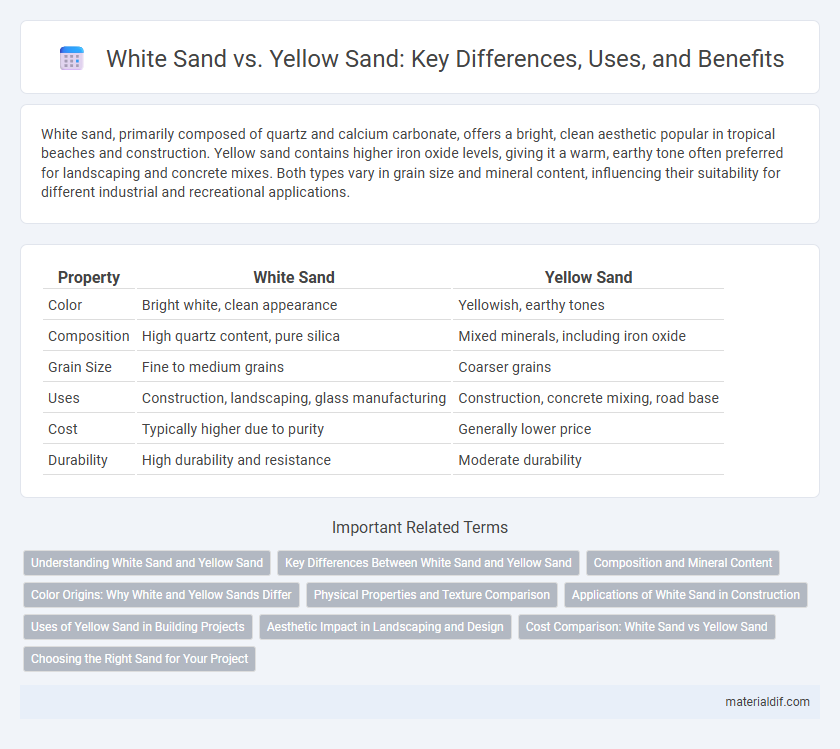White sand, primarily composed of quartz and calcium carbonate, offers a bright, clean aesthetic popular in tropical beaches and construction. Yellow sand contains higher iron oxide levels, giving it a warm, earthy tone often preferred for landscaping and concrete mixes. Both types vary in grain size and mineral content, influencing their suitability for different industrial and recreational applications.
Table of Comparison
| Property | White Sand | Yellow Sand |
|---|---|---|
| Color | Bright white, clean appearance | Yellowish, earthy tones |
| Composition | High quartz content, pure silica | Mixed minerals, including iron oxide |
| Grain Size | Fine to medium grains | Coarser grains |
| Uses | Construction, landscaping, glass manufacturing | Construction, concrete mixing, road base |
| Cost | Typically higher due to purity | Generally lower price |
| Durability | High durability and resistance | Moderate durability |
Understanding White Sand and Yellow Sand
White sand, primarily composed of quartz or calcium carbonate, offers a fine texture and high purity ideal for construction, glass making, and landscaping applications. Yellow sand contains higher iron oxide content, giving it a distinctive hue and slightly coarser particles suitable for concrete production and road base materials. Understanding the mineral composition and grain size of each sand type helps determine their best environmental and industrial uses.
Key Differences Between White Sand and Yellow Sand
White sand primarily consists of quartz and calcium carbonate, giving it a bright, reflective appearance ideal for beaches and construction. Yellow sand contains iron oxide impurities, which impart its characteristic warm hue and make it commonly preferred for local building projects. The differences in mineral composition influence their texture, color, and suitability for specific applications in landscaping and construction.
Composition and Mineral Content
White sand primarily consists of quartz and calcium carbonate, often derived from crushed seashells or coral, resulting in its bright, clean appearance. Yellow sand contains a higher concentration of iron oxide minerals, such as limonite and goethite, which give it its characteristic warm, earthy hue. The distinct mineral content influences not only the color but also the texture and weight, affecting its suitability for construction and landscaping projects.
Color Origins: Why White and Yellow Sands Differ
White sand derives its color primarily from quartz and coral fragments, which reflect sunlight, giving it a bright and reflective appearance. Yellow sand obtains its distinct hue from iron oxide and feldspar minerals, which impart warm, earthy tones due to oxidation processes. These differences in mineral composition and weathering influence the unique color variations observed between white and yellow sands on beaches and deserts.
Physical Properties and Texture Comparison
White sand, primarily composed of quartz or calcium carbonate, features a fine, smooth texture with a highly reflective surface that enhances brightness in coastal environments. Yellow sand contains more iron oxides and organic materials, resulting in coarser grains with a gritty texture and a warmer, earth-toned color. The density of white sand tends to be lower due to its fine particle size, while yellow sand exhibits greater compaction and weight, influencing its suitability for construction and landscaping.
Applications of White Sand in Construction
White sand, characterized by its high silica content and purity, is widely used in construction for producing high-quality concrete and glass due to its strength and clarity. Its fine texture and consistent grain size enhance mortar bonding and plaster smoothness, making it ideal for architectural finishes and decorative applications. White sand's resistance to impurities and chemical reactions ensures durability in building materials, promoting long-lasting structural integrity.
Uses of Yellow Sand in Building Projects
Yellow sand is preferred in building projects for its coarse texture and excellent drainage properties, making it ideal for concrete mixes, plastering, and bricklaying. Its higher clay and silt content improves workability and bonding strength in mortar, which enhances structural durability. The natural color of yellow sand also adds aesthetic value to render finishes and landscaping applications.
Aesthetic Impact in Landscaping and Design
White sand enhances landscaping and design with its bright, clean appearance, creating striking contrasts and a sense of spaciousness in outdoor spaces. Yellow sand, with its warm, earthy tones, adds natural warmth and rustic charm, blending seamlessly into garden pathways and Mediterranean-inspired environments. The choice between white and yellow sand significantly influences the visual mood, highlighting either modern minimalism or natural vibrancy in landscape aesthetics.
Cost Comparison: White Sand vs Yellow Sand
White sand typically incurs higher costs due to its purity and wide use in specialized applications like glass manufacturing and high-end construction, whereas yellow sand is more affordable and commonly used for general construction and landscaping. The extraction and processing expenses for white sand are greater, contributing to its premium price compared to the readily available yellow sand. Cost differences impact project budgeting, with yellow sand preferred for large-scale use due to economic efficiency.
Choosing the Right Sand for Your Project
White sand features fine, smooth grains ideal for decorative landscaping and beach volleyball courts, offering a clean, bright aesthetic that enhances visual appeal. Yellow sand, typically coarser and more abundant, provides superior drainage and compaction, making it suitable for construction projects like concrete mixing and foundation work. Selecting the right sand depends on project requirements such as texture, color, and structural properties to achieve optimal performance and durability.
White Sand vs Yellow Sand Infographic

 materialdif.com
materialdif.com